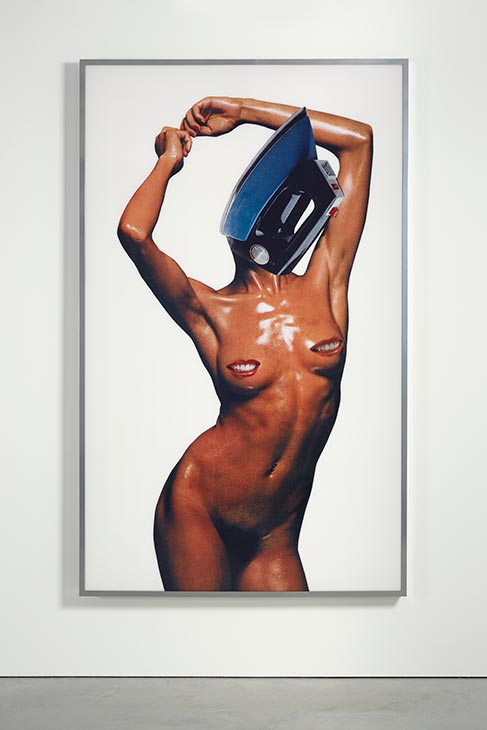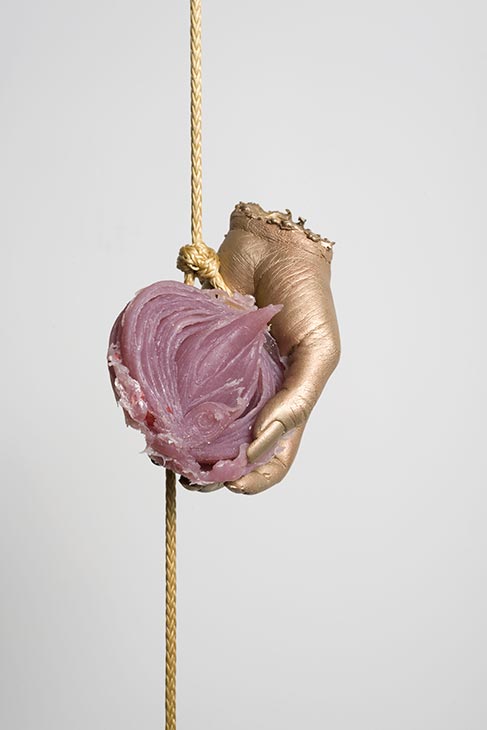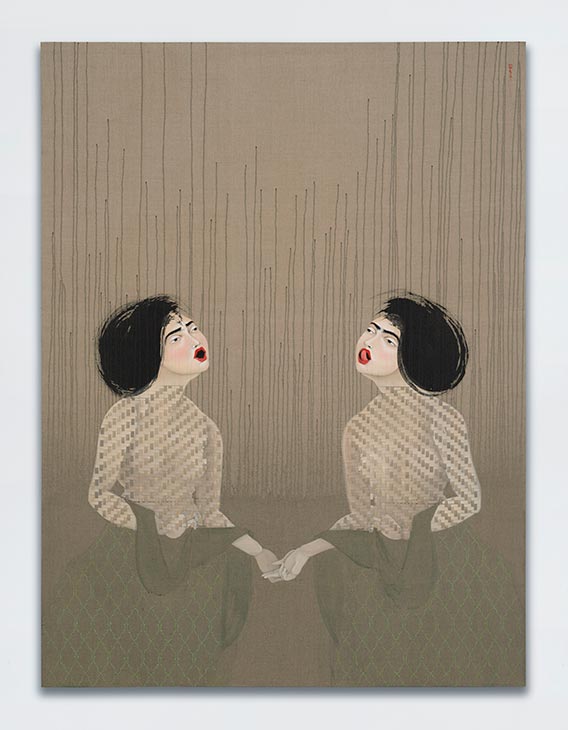Apollinaire coined the word ‘surreal’ to describe the joyful feeling of shock or marvel he found in the incongruous combinations of early ‘Surrealist’ works. The term has come, more recently, to be associated with those moments when the everyday warps and contorts, becoming the stuff of nightmare. ‘Dreamers Awake’ is less about escaping those nightmares than harnessing the unconscious from which they might creep. The exhibition – an extensive survey of Surrealism’s influence on the works of over 50 women artists – traces a longer history of their approach not only to artistic innovation, but to the challenge of expressing and redefining female selfhood against the male desires that drove Surrealism’s earliest manifestations.
Ranging through White Cube Bermondsey’s four considerable galleries, and including works by artists as far flung as Lee Miller, Mimi Parent, Leonora Carrington, Tracey Emin, Julie Curtiss, and Caitlin Keogh, ‘Dreamers Awake’ is grotesque, kitschy, farcical, and poignant by turns. Throughout, the notion of influence is key – not least because the visual apparatus drawn upon in many of the pieces on display ‘belongs’ to the works of male Surrealists with whom visitors are likely to be better acquainted. Woman as muse, as sphinx, as goddess; as torso decapitated and dismembered to heighten the focus on the breasts and sex: for all Surrealism’s apparent freedoms, the gendered violence practiced in the works of its male artists is an uncomfortable fact, if a surprising one to modern viewers more familiar with the movement’s revolutionary designs.
The exhibition’s excellent catalogue confronts this dubious gender politics head on, tracing its origins to the patriarchal system of Freudian psychoanalysis through which Surrealists sought access to the unconscious. For Susanna Greeves, the exhibition’s curator – whose comments appear in the catalogue – Surrealism’s women found new forms of protest and expression in the reappropriation of symbols traditionally associated with male desire. From the defaced and anonymous body parts we find in Magritte’s work, the grotesque contortions of Dalí’s nudes, the Frankensteinish play – of Breton and Masson – with lithe limbs of mannequins, arises a subversive exploration of female desire, embodiedness, and the fluid conditions of gender identity.
It’s The Buzz, Cock! (2015), Linder. © The artist. Courtesy Stuart Shave/Modern Art, London

One of the difficulties of this exhibition is that if you haven’t got access to a catalogue, the nuances of this history can be easily lost. I found myself wondering if it would undermine the worthy work of this all-female showcase to precede the exhibition proper with some notorious works of male Surrealism, or reproductions of them, at least: a line-up of offenders, from René Magritte’s Le Viol (1934) through Roland Penrose’s The Real Woman (1938), against which many of the pieces on display so vehemently react.
In some cases, the subtleties of this reaction can also get a little lost, in a space which sacrifices illuminating contextual detail for exhaustive range. The exhibition admirably situates exceptional younger artists – from Caitlin Keogh to Kelly Akashi – within a longer artistic heritage, which is both culturally diverse (Palestinian artist Mona Hatoum, and Iraqi artist Hayv Kahraman are included, among others) and gender aware (Claude Cahun’s photographic explorations of trans identity are a particular highlight). Yet bounty and its attendant lack of signage means that the richness of this diversity, and our knowledge of it, is occasionally obscured.
A sparrow’s heart (2009–10), Louise Bourgeois and Tracey Emin. © Tracey Emin

In the room dedicated to prints produced collaboratively by Tracey Emin and Louise Bourgeois, a word about the creative relationship between the two artists would have given depth to the sequence’s raw force. Bourgeois’s painted torsos – male and female, ominously clouded with gouache indigos and reds at belly, womb, penis – are overlaid with Emin’s tiny angular figures and outbreaks of text, which upturn habits of idiom, emotion and sex. The series reveals a cultural religion of desire, fuelled by fears of loss and abandonment: one female figure is literally hung-up on an erection, while another embraces a totemic phallus; ovaries, floating free of the body, strain to return to its interiors. The collaborative interplay of voices and body parts, Greeves tells us, is reminiscent of the Surrealists’ game of ‘cadaver exquis’ – a kind of pictorial ‘Consequences’ in which fantastical bodies emerged from the fanciful drawings of André Breton and Valentine Hugo. Unequipped with this knowledge in the gallery, what we might miss about this series is its play of influences, the clear sense of Emin, as a younger artist, engaging in the complexities of artistic lineage as her fantastical figures fondle Bourgeois’s monumental torsos. With a sense of the intimacies of artistic collaboration between two women, we lose the rawness of the need to fit, to belong, that lies at the heart of desire.
Untitled, from Early Color Portfolio (c. 1976), Jo Ann Callis. © Jo Ann Callis. Courtesy the artist and ROSEGALLERY

Elsewhere the exhibition experiments, in compelling ways, with the idea of Surrealism not only as a kind of artistic heritage, but as an unconscious process we might become aware of as viewers. Torso, rope, hair; object, skin, mask: this inventory of items – many reminiscent of the Freudian fetish object – provides an organisational structure that plays knowingly, often gleefully, with ideas of access and egress. How tantalisingly close might we be permitted to get to a piece, and how close might we want to be? We’re often reminded of the complex sense of interiority and depth that might lurk beneath the surface of the fetish, the kitschy, the kinky, and the cute. Jo Ann Callis’s preoccupation with marked bare skin – imprinted by bindings, adorned with unnatural beauty spots, seamed like a stocking’s back – results in a set of staged photographs that baffle voyeuristic impulses with erotic trappings that aren’t quite right, that seem to exist in a world where desire works differently. In the same room, Maria Bartuszová’s ponderous yet mesmerising bronze Rebound Torso (1984), trussed like a butcher’s parcel, offers a visual echo to Callus’ prints: flesh under pressure is woman as inert meat, even as we’re drawn to the allure of its taut bindings and its curiously vital weight. Like Hannah Wilke’s set of Five Androgynous and Vaginal Sculptures (1960–61) – a series of modest terracotta forms that revel in the possibility of gender both deformed and reformed – grotesquerie is something we find ourselves wanting to embrace or grasp, to touch or nestle in the hand.
Well (-) Hung (2017), Kelly Akashi. © The artist. Courtesy the artist and Ghebaly Gallery, Los Angeles. Photo: Jeff McLane

Indeed, if Freud’s fetish object was a site of male horror – a fear of female genitalia and the latent suggestions of castration to be found there – many of the works on display don’t flinch from the prospect of repulsing their viewers as much as they entice them. There is meaningful weight in their initial absurdity and bawdiness, revulsion and hilarity. A cluster of works that play with hair are especially good at bringing observers to the brink of disgust, even as they evoke the prospect of contact, of the stroking that hair so often invites. Helen Chadwick’s brilliant I Thee Wed (1993) presents us with five phallic forms – what appear to be a prickly species of gherkin – each of which is encircled by a furry ring, save one, which awaits its moment of ceremonial glory. A small ring of fur, sitting before it, anticipates the ridiculous deed – and invites us to participate in this marriage of fetishes.
But just as physical contact with them lies beyond the gallery visitor’s bounds, many of these pieces repulse all thoughts of touch, and the easy appropriation of the feminine body that comes with it. Mona Hatoum’s Jardin Public (1993) offers a wry comment on the woman’s body as it exists in the public eye: a wrought iron chair, reminiscent of elegant, al-fresco cafe culture repulses the viewer with its little patch of pubic hair, of intimate womanhood on show. In a similar way, her Hair Necklace (2013), close-by, recalls the mourning jewellery of Victorian relic culture – a form of emotional ritual that becomes a reflection on the fetishisation of intimacy, on the public life of the delicate business of feeling.
In the spaces they open up between longing and aversion, these pieces invites us to recognise the joys and cravings, the absurdities and abhorrences that come with woman’s existence. They induce our awakening: to the rich and elaborate performance of female selfhood.
T25 and T26 (2017), Hayv Kahraman. © Hayv Kahraman. Courtesy the artist and Jack Shainman Gallery, New York

‘Dreamers Awake’ is at White Cube, Bermondsey, until 17 September.



